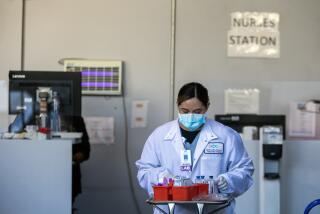Vaccinated California employees face workplace restrictions

SACRAMENTO — In a move criticized by business groups and hailed by labor advocates, California’s workplace regulators on Thursday extended the state’s COVID-19 pandemic regulations into next year with revisions that employers said could worsen the state’s severe labor shortage.
Vaccinated and unvaccinated employees in the most populous U.S. state will be treated the same under the California Occupational Safety and Health Standards Board’s revised rules.
Under the rules that take effect Jan. 14 and are set to last for three months, both groups will be prohibited from the workplace if they come in close contact with someone infected with the virus.
The new rules mark a reversal of the state’s coronavirus workplace regulation. The current rules allow vaccinated employees to keep working at workplaces even if they’ve been exposed, unless they show symptoms — under the assumption that the vaccine generally will protect them.
The revised temporary rules would require that exposed, vaccinated but asymptomatic workers stay home for 14 days even if they test negative or, if they return to work, wear masks and stay 6 feet from anyone else during those two weeks.
The seven-member safety board is the policymaking arm of what is known as Cal/OSHA. It adopted the revised rules without discussion on a 6-1 vote.
California imposes a new mask mandate amid growing concerns that a winter surge in COVID-19 cases could once again strain hospitals.
Business groups argued the new rules will be particularly onerous for small businesses, including restaurants and retailers.
“Treating vaccinated and unvaccinated people similarly really denies the scientific value of the vaccine and disincentivizes vaccination,” said Rob Moutrie, a policy advocate at the California Chamber of Commerce.
But groups representing California workers supported the changes. Mitch Steiger, a legislative advocate for the California Labor Federation, said regulators in the summer were foolish to loosen COVID-19 workplace restrictions put in place earlier during the pandemic.
“It’s good that we’re realizing that vaccines aren’t the silver bullet to get us out of this,” Steiger said. “There’s never a good time to start disarming against COVID-19.”
The safety board’s adoption of the revised rules came a day after California reinstituted requiring vaccinated and unvaccinated people to wear masks indoors in a bid to slow the spread of the virus, including the Omicron variant, as families and friends gather for the holidays and new coronavirus cases increase.
Safety board members recognized “the science that vaccinated people can transmit the virus, and early reports show that to be especially true with Omicron,” said Saskia Kim, speaking for the California Nurses Assn.
A rise in COVID-19 due to Omicron could result in a ‘perfect storm for overwhelming our hospital system,’ a Southern California health official says.
Other states besides California that have adopted emergency COVID-19 workplace safety measures include Michigan, Oregon and Virginia.
The Biden administration has ordered all U.S. employers with more than 100 workers to require them to be vaccinated, tested regularly or wear masks at work starting Jan. 4. But the order is stalled amid court challenges from Republican-led states and fears among employers that the rules could make the worker shortage worse.
The California Chamber of Commerce led a coalition of about 60 business groups arguing in a letter to the state safety board that vaccinations are still largely effective and usually prevent serious illness and death even if there are breakthrough infections.
The groups warned that the new rules to require testing of vaccinated workers with no symptoms could strain the availability of rapid tests and boost employers’ costs. The rules apply to almost every workplace in the state, including offices, factories and retail locations.
The stricter safeguards “will only worsen the present labor shortage affecting California workplaces,” Moutrie said. “Moreover, reinstituting social distancing on a per person basis is just not feasible in many work places” that would have to physically move workstations or equipment.
California has a huge entertainment business sector and the Motion Picture Assn. of America’s vice president and senior counsel, Melissa Patack, told the board that the rules aren’t feasible for filming movies, television shows or commercials because “actors cannot wear masks while performing.”
Workers doing hair and makeup for actors cannot stay 6 feet apart, so the new rules “could result in the shutdown of many productions,” she said.
More cases of the Omicron coronavirus variant are reported in Los Angeles, San Bernardino and Ventura counties as new state mask order takes effect.
Although California labor groups generally backed the workplace changes involving vaccinated and unvaccinated workers, they are upset that other proposed rules to be considered in March would eliminate mandatory employer-paid sick leave for workers who get infected with the virus or are exposed to it.
That temporary rule is aimed at allowing lower-wage workers without sick time to take time off rather than spreading the virus at work because they couldn’t afford to stay home.
Doing away with it would mean that “workers will be forced to make the impossible decision of going to work while sick or staying home without pay,” Stephen Knight, executive director of the labor advocacy group WorkSafe, said in an online petition to the Cal/OSHA Standards Board.
Labor advocates could also work through the state budget process, Legislature and governor to keep the program, but prefer to retain the existing requirement, Knight and Steiger said.
Here’s more information on the variant, and a look at the current state of California’s handling of COVID-19.
More to Read
Sign up for Essential California
The most important California stories and recommendations in your inbox every morning.
You may occasionally receive promotional content from the Los Angeles Times.














